Knowing the right DIY armoire moving techniques is very important in order to relocate these large, heavy furniture pieces without personal injury or damages. The best way to move armoires starts with proper preparation and full padding. Once your furniture has been fully and snugly padded, you will be ready to learn how to move an armoire.
How to Prepare an Armoire for Moving
First, take out all shelves from your large wood furniture piece and bundle wrap it into a moving blanket. Then, place another blanket around the bundle and tape it without allowing the tape to come in contact with the wood finish (tape residue is sticky and very hard to remove).

Next, check the armoire’s doors (if any) to see if they can be easily removed. If so, remove the doors and blanket wrap them. If you think the piece’s doors are best left attached during the move, reverse any protruding door handles or knobs.

How to Wrap an Armoire for Moving
Your next step is to fully pad the top and bottom of the piece (as shown in the picture sequence below), securing the pads tightly with tape. Padding protects the piece from scratches while also holding the doors shut during moving.
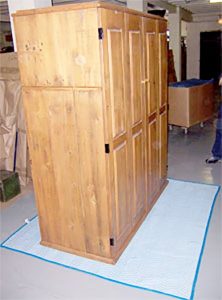
Notice that this big armoire is placed on the bottom pad so that the majority of it will lift up to cover the front as shown in the pictures. It will not cover the back which will not be fully padded because any scratches occurring there won’t matter. If you want to fully pad the front and the back of your armoire, then center the piece on a pad so that it lifts up evenly front and back.
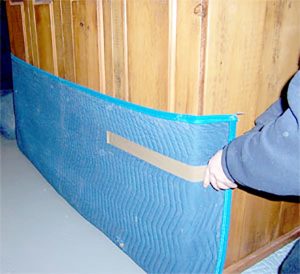
As the tape is applied to hold the pad up, it is squeezed into a line by the mover so that no residue can get onto the finish on the armoire’s side. Then the very bottom is carefully taped all around it as shown in the picture below.

Next, the top is evenly padded all around the armoire and securely taped just as the bottom was. Again, do not tape the armoire’s finish – only the pads – in order to avoid tape residue problems.
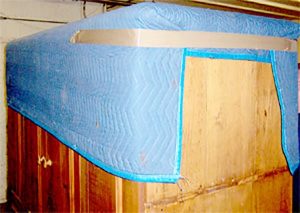
Then pads are wrapped all around the open middle of the front and the sides of the armoire and tightly taped into place.
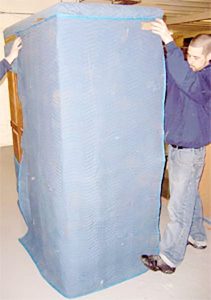
Finally, plenty of tape is wrapped around the whole armoire in order to secure the pads tightly to the piece.
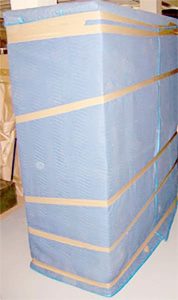
It is also advisable to tape cardboard over the part of the pads that
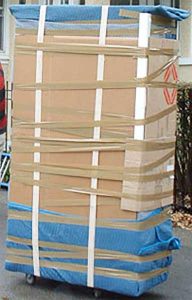
How to Move Drawers
You can leave the drawers in the unit but make sure there are no trinkets or heavy items in them. You can only allow a little bit of light clothing to stay in the drawers because a heavily loaded drawer can break its glides as it is being moved or loaded. Leaving the empty drawers in the unit solidifies the piece while it’s being moved. Keeping the drawers in the unit also makes all of it easier to store on the truck since the drawers won’t have to be stacked separately somewhere else, taking up more truck space.
If it’s a very heavy armoire, then remove the drawers to lighten it and carry them separately to and from the truck. But remember, they will take up extra truck space. Normally, it’s best to use a dolly to move big furniture pieces like armoires but if you need to carry them, be sure to use a humpstrap.
If you’re not up to the task, or don’t want to risk it, call a professional moving company for help – fill out a free moving quote to get in touch with several reputable movers in your area, see what they have to offer, compare their estimates, and choose the best moving partners for you. Your armoire will arrive at your new home intact and unscathed and you’ll be able to congratulate yourself on your smooth and successful relocation.


